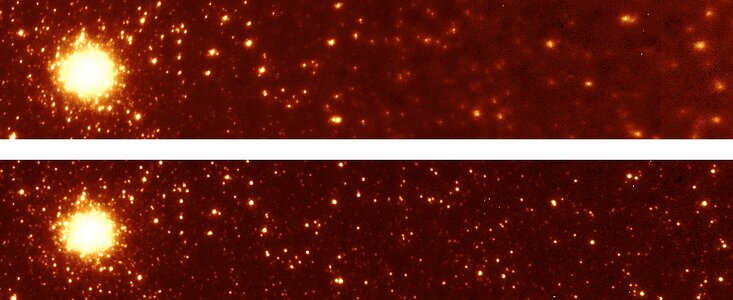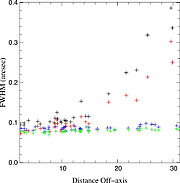Altair Undergoes Successful Performance Upgrade
28 October 2005
The recent addition of a field lens in the Altair adaptive optics system has resulted in a significant improvement in near-infrared imaging capabilities at Gemini North. Altair with the field lens will begin regular science use in semester 2006A.
Adaptive Optics - Straightening Bent Starlight
Adaptive optics (AO) technology uses deformable mirrors to remove distortions to starlight caused by turbulence in Earth's atmosphere. Using this technology, astronomers can improve near-infrared images to rival the resolution of space-based observations. The technology is rapidly evolving and technologies such as laser guide stars and 3-dimensional turbulence mapping (multi-conjugate AO) are making the technology even more powerful.
The lens was installed based on recent turbulence monitoring that demonstrated that about 60% of the turbulence on Mauna Kea occurs close to the ground. Altair was originally designed based on the assumption of a dominant turbulence layer at 6.5 kilometers. According to Gemini’s Associate Project Scientist for Adaptive Optics, Dr. François Rigaut, “These results give us a taste of what is coming with our Multi-Conjugate Adaptive Optics [MCAO] system at Gemini South, in terms of accessible field of view and uniformity of image quality. In addition, MCAO will provide this uniformity over 10 times the field of the M33 images in nearly all seeing conditions.”
Figure 2 illustrates the relationship between the full-width-half-maximum (FWHM) of stellar images before and after the use of the field lens. With the field lens inserted into the optical path, the point-spread function of the stellar images is extremely uniform out to at least 30 arcseconds from the guide source, as indicated by the flatness of the blue and green crosses in Figure 2. The data for this plot came from the images presented in Figure 1 of the core of M33 in H-band. geminiann05014d shows a color composite from additional data in J, H and K bands also obtained with Altair using the field lens.
All images were obtained with Altair feeding the Gemini Near Infrared Imager at f/32 during field lens commissioning in August and September 2005. A known limitation is an 8% throughput loss using the temporary silica lens, but this will be reduced soon when it is replaced with a CaF2 lens.
Commission at f/14 is also underway as illustrated by the K’, K+H2, FeII (iron II) color composite image of the planetary nebula M2-9 (geminiann05014e). A comparison with the HST image of the same object (in the optical) is provided for comparison.





